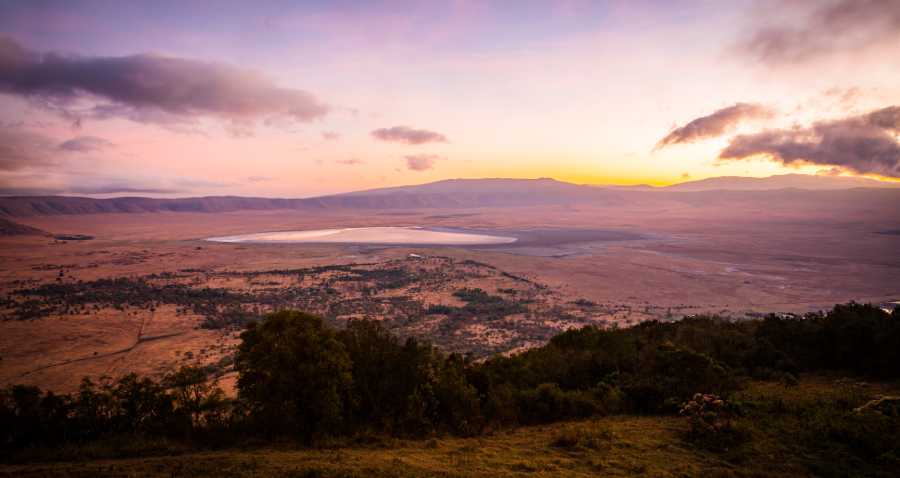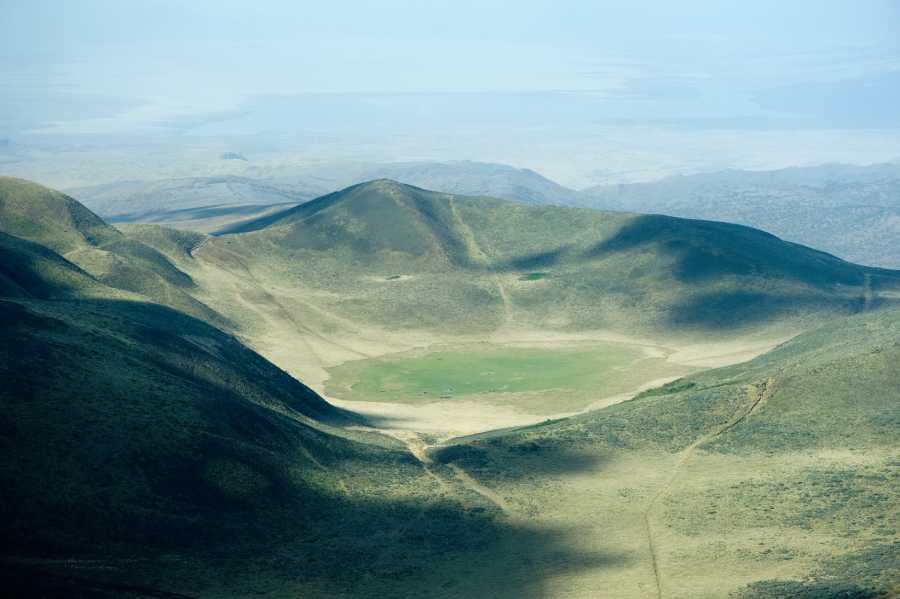Travel To Tanzania’s Ngorongoro Crater on Safari
Download Travel Details >PRIVATE & SMALL GROUP TOURS TO THE WORLD'S BEST DESTINATIONS
Join Us For A Safari In Tanzania

A Visit To Africa’s Garden Of Eden
The Ngorongoro Crater is located in the Great Rift Valley in Northern Tanzania. This incredible crater, a UNESCO world heritage site, is an easy addition to any Serengeti Safari Tour. Part of Tanzania’s Northern Safari Circuit, the Ngorongoro Crater is one of the most visited tourist attractions in Africa.
But what makes the crater so special? The crater is unique because it is home to thousands of animals, making the crater floor the world's only natural zoo! Keep reading to find out whyyou should include this incredible crater on your Serengeti tour itinerary.

What Is The Ngorongoro Crater?
The Ngorongoro Crater is the world’s largest intact volcanic caldera, covering 100 square miles and measuring 12 miles in diameter! This massive, bowl-like depression is often referred to as “Africa’s Garden of Eden” due to the sheer volume of wildlife that lives within its depths. The crater’s landscape is varied and contains forests, lakes, swamps, grasslands, and glades. Each ecosystem houses critically endangered animals, as well as a huge variety of flora – making the site a true natural wonder.
5 Fun Facts About The Ngorongoro Crater
The Ngorongoro Crater is located within the Ngorongoro Conservation Area in Northern Tanzania. It is within driving distance of the Serengeti National Park. It is also a UNESCO World Heritage Site and is known for its stunning landscapes and abundant wildlife, making it a popular destination for safari enthusiasts.
The crater is home to lions, elephants, buffaloes, wildebeest, zebra, hippos, rhinos, hyenas, cheetahs, and a variety of birds. In the forests on the crater rim, away from the floor, live other animals like leopards, reedbuck, warthogs, and sometimes cheetahs and leopards. The diverse ecosystem within the crater provides a unique opportunity for visitors to witness a rich concentration of wildlife coexisting in harmony within a confined space.
Here are five fun facts to pique your interest before you visit Ngorongoro Crater on your Serengeti Safari Tour!
- The Ngorongoro Crater houses a 7-mile lake! Located in the center of the caldera, Lake Magadi is a gathering place for the crater’s varied wildlife. One of the highlights of visiting this lake is seeing the large population of flamingoes spread across its surface. Thousands of this leggy bird flock to the crater’s lake during the rainy season. Visitors can also see hippos, warthogs, and pelicans at Lake Magadi.
- The Ngorongoro Crater is home to extremely rare animals. If you have planned a Serengeti Safari Tour specifically to spot the elusive and endangered Black Rhino, the Ngorongoro Crater is where you can find them! Approximately 20 black rhinos live in the protected Ngorongoro Crater area.
- Is the Ngorongoro Crater the cradle of life? Well, no, but it is an important place for human archeological research! Many significant archaeological findings have been found in Ngorongoro, including fossilized footprints dating back 2-3 million years. Findings also suggest that humans have inhabited the area for over 3 million years.
- Ngorongoro is home to a diversity of wildlife! The Crater’s list of wildlife superstars includes buffalo, hyenas, elephants, zebras, lions, and more. And the feathered inhabitants are just as numerous! There are more than 500 species of birds living in the Crater, including the Livingstone Turaco, the black kite, ostrich, flamingos, and even hummingbirds.
- Ngorongoro Crater is part of the Great Migration. Each year, the great herd of migrating mammals travels through Ngorongoro during the Great Migration. The herd moves seasonally between the Serengeti Plains and the Ngorongoro Conservation area, with most gathering in the Ngorongoro Crater. If you have planned your Serengeti Safari Tour to coincide with the Great Migration, a stop in Ngorongoro is a must!
What Is The Best Time To Visit Ngorongoro Crater?
 The wildlife that calls Ngorongoro Crater home remains there all year round. So, the best time to visit Ngorongoro Crater depends entirely on your preferences. If you want to avoid crowds or save a little money from your travel budget, the time of year can make a difference.
The wildlife that calls Ngorongoro Crater home remains there all year round. So, the best time to visit Ngorongoro Crater depends entirely on your preferences. If you want to avoid crowds or save a little money from your travel budget, the time of year can make a difference.
Many seasoned safari-goes consider March to be one of the best times to visit the Ngorongoro Crater to avoid crowds and take advantage of reasonable rates. The only downside to traveling during the early spring is that the long rains are just beginning. However, the rains transform the crater into an emerald paradise, which could be considered a plus for some travelers.
Here is a breakdown of what to expect during the wet and dry seasons in Ngorongoro:
- The Dry Season (June to October) - The dry season is considered the best time to visit Ngorongoro Crater. From June to October, visitors will experience fantastic wildlife sightings, comfortable weather, and clear skies in the Crater. And, as the dry season progresses, the lush vegetation carpeting the crater floor thins out, making it easier to spot the more elusive species of animals that live in Ngorongoro. The lack of water in other areas of the Serengeti also attracts animals to Lake Magadi, which ensures a higher concentration of wildlife sightings for safari goers.
- Wet Season (November to May) – The wet season is considered the “low season” for safaris in the Ngorongoro Crater. This means that there are fewer crowds and deep discounts on safaris and accommodations for tourists. The wet season still presents unique opportunities for travelers to enjoy the Crater’s vibrant vegetation, blooming flowers, and varied birdlife. Although wildlife may be scattered among the newly created water holes during the wet season, it’s still possible to experience remarkable animal encounters on a Serengeti Tour during these months.
5 Fun Safari Activities In Ngorongoro Crater
Once you have chosen the best time to visit Ngorongoro Crater, you will need to pick a few fun activities to make your safari memorable! After deciding on the activities, consider booking a guided tour to fully immerse yourself in the rich wildlife and stunning landscapes of Ngorongoro Crater. There are a variety of options available to customize your safari experience, including:
- Photo safaris – these small-group tours offer travelers a luxury safari tour with like-minded individuals and the chance to capture exclusive photos of big game in the Ngorongoro Crater.
- Meet the Maasai tribe – many tour companies offer adventurers the opportunity to meet Tanzania’s nomadic Maasai people. Discover the homes and traditions of the Maasai through traditional dance performances and other cultural exchanges.
- Walking safaris – explore the Ngorongoro Crater’s wildlife on foot with a professional guide that can explain the unique flora and fauna of the region to your group.
- Hot air balloon tour – take a scenic hot air balloon flight over the Ngorongoro Crater for a unique perspective on the incredible wildlife below.
- 4x4 Safari – this self-guided game drive is for the adventurous! Rent a luxury 4x4 and take a journey into the crater to enjoy the scenery and wildlife at your own pace.
A Serengeti Tour To Remember
The Ngorongoro Crater offers visitors a classic Big 5 safari experience against the backdrop of a stunningly diverse landscape. Travelers that have additional time to spend in Tanzania will find that Ngorongoro’s location makes it easy to combine a safari in the ancient volcanic caldera with a Serengeti Safari tour or a game drive in Tarangire National Park and Lake Manyara. This natural wonder is the perfect jumping-off point for a once-in-a-lifetime adventure across Tanzania’s Northern Safari Circuit.

